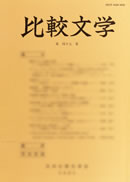Volume 35
Displaying 1-28 of 28 articles from this issue
- |<
- <
- 1
- >
- >|
-
1993 Volume 35 Pages 9-12
Published: March 31, 1993
Released on J-STAGE: July 31, 2017
Download PDF (1058K) -
1993 Volume 35 Pages 13-15
Published: March 31, 1993
Released on J-STAGE: July 31, 2017
Download PDF (665K) -
1993 Volume 35 Pages 16-20
Published: March 31, 1993
Released on J-STAGE: July 31, 2017
Download PDF (1348K) -
1993 Volume 35 Pages 21-23
Published: March 31, 1993
Released on J-STAGE: July 31, 2017
Download PDF (719K)
ARTICLES
-
Article type: SPECIAL SECTION ON AKUTAGAWA
1993 Volume 35 Pages 25-37
Published: March 31, 1993
Released on J-STAGE: June 17, 2017
Download PDF (3797K) -
Article type: SPECIAL SECTION ON AKUTAGAWA
1993 Volume 35 Pages 39-49
Published: March 31, 1993
Released on J-STAGE: June 17, 2017
Download PDF (3360K) -
Article type: SPECIAL SECTION ON AKUTAGAWA
1993 Volume 35 Pages 51-61
Published: March 31, 1993
Released on J-STAGE: June 17, 2017
Download PDF (3367K) -
1993 Volume 35 Pages 63-74
Published: March 31, 1993
Released on J-STAGE: June 17, 2017
Download PDF (3791K) -
1993 Volume 35 Pages 75-88
Published: March 31, 1993
Released on J-STAGE: June 17, 2017
Download PDF (4163K) -
1993 Volume 35 Pages 89-101
Published: March 31, 1993
Released on J-STAGE: June 17, 2017
Download PDF (3447K) -
1993 Volume 35 Pages 103-115
Published: March 31, 1993
Released on J-STAGE: June 17, 2017
Download PDF (3834K) -
1993 Volume 35 Pages 117-128
Published: March 31, 1993
Released on J-STAGE: June 17, 2017
Download PDF (3590K) -
1993 Volume 35 Pages 129-139
Published: March 31, 1993
Released on J-STAGE: June 17, 2017
Download PDF (3354K) -
1993 Volume 35 Pages 266-247
Published: March 31, 1993
Released on J-STAGE: June 17, 2017
Download PDF (5253K)
NOTES
-
1993 Volume 35 Pages 141-150
Published: March 31, 1993
Released on J-STAGE: June 17, 2017
Download PDF (3115K) -
1993 Volume 35 Pages 151-166
Published: March 31, 1993
Released on J-STAGE: June 17, 2017
Download PDF (4598K)
-
1993 Volume 35 Pages 167-177
Published: March 31, 1993
Released on J-STAGE: July 31, 2017
Download PDF (3522K)
-
1993 Volume 35 Pages 179-182
Published: March 31, 1993
Released on J-STAGE: July 31, 2017
Download PDF (1252K) -
1993 Volume 35 Pages 182-186
Published: March 31, 1993
Released on J-STAGE: July 31, 2017
Download PDF (1573K) -
1993 Volume 35 Pages 186-189
Published: March 31, 1993
Released on J-STAGE: July 31, 2017
Download PDF (1323K) -
1993 Volume 35 Pages 189-193
Published: March 31, 1993
Released on J-STAGE: July 31, 2017
Download PDF (1696K) -
1993 Volume 35 Pages 193-198
Published: March 31, 1993
Released on J-STAGE: July 31, 2017
Download PDF (1997K) -
1993 Volume 35 Pages 198-201
Published: March 31, 1993
Released on J-STAGE: July 31, 2017
Download PDF (1424K) -
1993 Volume 35 Pages 202-205
Published: March 31, 1993
Released on J-STAGE: July 31, 2017
Download PDF (1289K) -
1993 Volume 35 Pages 205-209
Published: March 31, 1993
Released on J-STAGE: July 31, 2017
Download PDF (1656K) -
1993 Volume 35 Pages 209-213
Published: March 31, 1993
Released on J-STAGE: July 31, 2017
Download PDF (1500K) -
1993 Volume 35 Pages 213-216
Published: March 31, 1993
Released on J-STAGE: July 31, 2017
Download PDF (1173K)
-
1993 Volume 35 Pages 246-232
Published: March 31, 1993
Released on J-STAGE: July 31, 2017
Download PDF (3459K)
- |<
- <
- 1
- >
- >|
